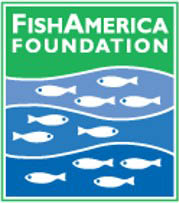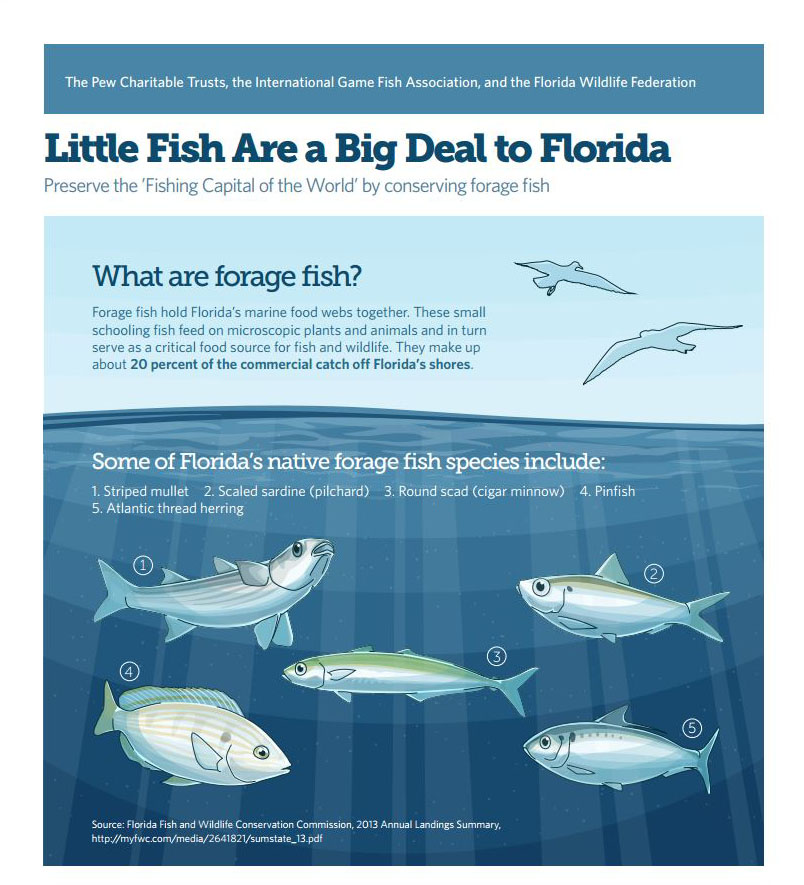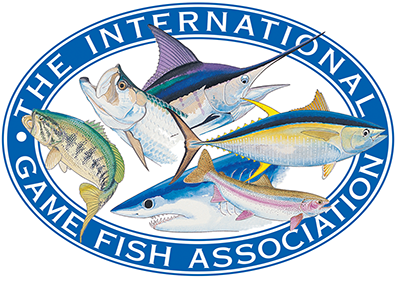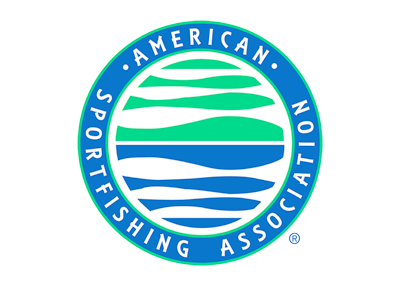The FishAmerica Foundation is the American Sportfishing Association’s conservation and research foundation. We unite the sportfishing industry with conservation groups, government natural resource agencies, corporations and foundations to invest in sportfish and habitat conservation and research across the country.
FISH FLORIDA, a 501(c)(3) non-profit organization, supports organizations that teach people, especially children, about Florida’s fish and aquatic habitats through donations of fishing equipment, grants, and scholarships.
The mission of Fish Florida is to promote public awareness of and encourage the protection of marine fisheries and coastal habitats. This is accomplished through clinics, classes, seminars, presentations, displays and other means designed to teach and promote responsible angling, particularly to Florida’s youth.
When you buy a Grady-White boat you aren’t just purchasing the most exceptional boat on the market, you’re becoming part of the family of Grady owners! We’re a welcoming group who together enjoy a variety of activities from fishing tournaments, seminars and customer appreciation parties to raft ups, and overnight or day trips. First time boat owners will enjoy traveling with seasoned Grady owners where you’ll discover all the best places to enjoy your favorite boating activity. The best part is the camaraderie you’ll derive from Grady ownership. So, climb aboard The Grady Life and experience the best boating lifestyle.
the
fish
What are forage fish?
Forage fish are small to medium-sized schooling fishes that typically mature early and have short life spans. Sardines, anchovies, and menhaden are classic examples, but many other species like goggle eyes, mullet, pinfish, and ballyhoo also have similar life cycles.
Why do forage fish matter?
Forage fish represent the first vertebrate link in marine food webs. They feed predominantly on small plant and animal matter and, in turn, transfer this energy to higher trophic levels where they are subsequently preyed on by larger, predatory fish such as redfish, snook and sailfish. Therefore, fisheries managers need to determine how many forage fish can be harvested and how many need to be left in the ocean in order to properly fulfill their role as food for larger fish species and animals.
How are forage fish harvested?
Globally, forage fish account for nearly one-third of all marine fish that are harvested annually. The majority (90%) are processed for aquaculture, feed for poultry and livestock, and nutritional supplements for people. In Florida, forage fish constitute 20% of all commercial catches.
Meet some of Florida’s important forage fish species
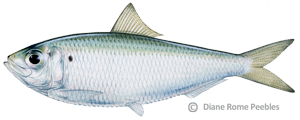
Scaled sardine or pilchard (Harengula jaguana)
Most people in Florida refer to scaled sardines as pilchards. Pilchards are common inshore and nearshore along both coasts of Florida. They have a maximum size of approximately 15 cm, rarely live more than a year, and are often misidentified with their close relative, the false herring (Harengula clupeola). One study reported that pilchards are heavily preyed upon by king and spanish mackerels, little tunny, gag grouper, bluefish, crevalle jack, yellowfin tuna, and dolphin. Total statewide landings of scaled sardine in 2012 were 29,365 pounds. No formal stock assessment exists for this species.

Atlantic thread herring (Opisthonema oglinum)
Thread herring are common in Florida and occur from the Gulf of Maine on the east coast throughout the Gulf of Mexico and the Caribbean southward to Brazil. They can be readily identified by their last dorsal fin ray, which is long and filamentous.Thread herring have a lifespan of at least three years and become reproductively mature at between 4.7 and 5.7 cm in fork length at roughly age one or two. Spawning takes place in nearshore waters from March through July. The 2013 landings for threadfin were 1.7 million pounds. No formal stock assessment exists for this species.
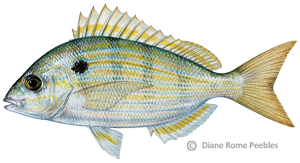
Pinfish (Lagodon rhomboides)
This well-known species of forage fish is a ubiquitous resident of Florida’s extensive sea grass beds. Pinfish may live as long as seven years and a two year old fish averages five inches in length. They mature by age one or two when they are approximately 4.3 inches in length. Pinfish exhibit seasonal migrations where they move to offshore habitats during the fall, where they reside and spawn through the spring. They are an important prey item for many species of fish including redfish, seatrout, and even gag grouper during winter months. Pinfish feed on a variety of invertebrates but as they grow, the shape of their teeth change and their intestines increase in length as they graze on more plant material. The 2013 landings for pinfish were 45,852 pounds. No formal stock assessment exists for this species.
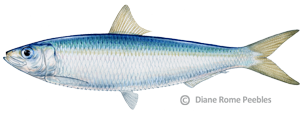
Spanish sardine (Sardinella aurita)
Spanish sardines can be encountered in Florida from the shoreline out to depths of 100 feet, but the highest concentrations occur at depths less than 65 feet. They exhibit diurnal vertical migrations where schools spend more time near the bottom during the day and utilize more of the water column at night. Spawning evidence is conflicting but is thought to occur year-round primarily along the Gulf coast shelf. After spawning, adults undertake migrations to nearshore feeding areas. Spanish sardines have a lifespan of only 4 years and can reach 7.5 inches in fork length. Females become sexually mature by their second year when they are approximately 5.3 inches in length. Females grow faster and larger than males. Key predators of Spanish sardines include grouper, bluefish, crevalle jack, spanish and king mackerel, and yellowfin tuna. Spanish sardines are harvested in Florida primarily with purse seine nets and 2012 landings were just under one million pounds.
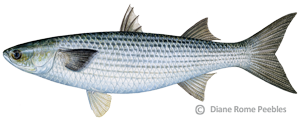
Striped mullet (Mugil cephalus)
Striped mullet are found worldwide and occur throughout Florida. They have somewhat of a catadromous lifecycle where they inhabit fresh and brackish water habitats but spawn in the sea. Unlike other forage fish, striped mullet are fairly long-lived and may reach nine to 13 years in age. They can grow to 20 inches in total length and become sexually mature at two to three years of age when they are approximately 11.5 inches in fork length. Spawning occurs in the outer continental shelf at depths over 5,000 feet during November through January. Striped mullet feed primarily on benthic microalgae, detritus, and sediment particles. They are important forage for common snook, spotted seatrout, red drum, southern flounder, and a variety of birds. Striped mullet have been regulated in Florida since 1989 and harvest was substantially reduced by the 1995 constitutional amendment that banned the use of entangling nets in Florida waters. The last stock assessment was conducted in 2008 and indicated that striped mullet are well-managed and are not overfished or experiencing overfishing. The next stock assessment is due at the end of 2014. Total landings in 2012 were 9,599,144.
Our mission is to keep the oceans wild to preserve fishing opportunities for the future. To do this, we bring conservation-minded fishermen and pro-fishing environmentalists together to promote a broad, ecosystems approach to fisheries management that reflects our expanding circle of concern for all marine life and the future of fishing.
FISH FLORIDA, a 501(c)(3) non-profit organization, supports organizations that teach people, especially children, about Florida’s fish and aquatic habitats through donations of fishing equipment, grants, and scholarships.
The mission of Fish Florida is to promote public awareness of and encourage the protection of marine fisheries and coastal habitats. This is accomplished through clinics, classes, seminars, presentations, displays and other means designed to teach and promote responsible angling, particularly to Florida’s youth.
Since 1936, the Florida Wildlife Federation (FWF) has united Floridians throughout the state who are determined to ensure that wildlife and our fragile environment have a voice. FWF believes that we must protect, restore and connect our remaining wildlife habitats in a rapidly developing state. We must address ongoing climate change and the spread of harmful exotic species, both plant and animal, that threaten our native species. Moreover, we must safeguard water quality and quantity as clean water is critically important to both humans and wildlife.
The Angler Action Foundation improves angler access, fisheries science and marine habitat through collaborative Research, Education and Conservation programs.
We support unbiased and responsible fishery and marine regulations and conservation, preservation, restoration, and enhancement of estuarine and coastal water habitats.
For more than 85 years, ASA has passionately represented the people, policies and ideas that help recreational fishing thrive. They give the industry and anglers a unified voice when emerging laws and policies could significantly affect sportfishing business and participation. ASA invests in long-term ventures to ensure the industry remains strong and prosperous, as well as safeguard and promote the enduring economic, conservation and social values of sportfishing in America.
TBEP is an intergovernmental partnership of Hillsborough, Manatee, Pasco and Pinellas counties; the cities of Tampa, St. Petersburg and Clearwater; the U.S. Environmental Protection Agency (EPA); the Southwest Florida Water Management District (SWFWMD); and the Florida Department of Environmental Protection (FDEP).
The FishAmerica Foundation is the American Sportfishing Association’s conservation and research foundation. We unite the sportfishing industry with conservation groups, government natural resource agencies, corporations and foundations to invest in sportfish and habitat conservation and research across the country.
FISH FLORIDA, a 501(c)(3) non-profit organization, supports organizations that teach people, especially children, about Florida’s fish and aquatic habitats through donations of fishing equipment, grants, and scholarships.
The mission of Fish Florida is to promote public awareness of and encourage the protection of marine fisheries and coastal habitats. This is accomplished through clinics, classes, seminars, presentations, displays and other means designed to teach and promote responsible angling, particularly to Florida’s youth.
When you buy a Grady-White boat you aren’t just purchasing the most exceptional boat on the market, you’re becoming part of the family of Grady owners! We’re a welcoming group who together enjoy a variety of activities from fishing tournaments, seminars and customer appreciation parties to raft ups, and overnight or day trips. First time boat owners will enjoy traveling with seasoned Grady owners where you’ll discover all the best places to enjoy your favorite boating activity. The best part is the camaraderie you’ll derive from Grady ownership. So, climb aboard The Grady Life and experience the best boating lifestyle.

